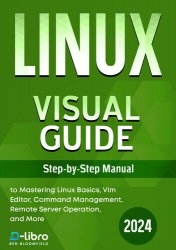Linux Visual Guide: Step-By-Step Manual for Complete Beginners to Mastering Linux Basics, Vim Editor, Command Management
- Добавил: literator
- Дата: 8-07-2024, 09:56
- Комментариев: 0
 Название: Linux Visual Guide: Step-By-Step Manual for Complete Beginners to Mastering Linux Basics, Vim Editor, Command Management, Remote Server Operation, and More
Название: Linux Visual Guide: Step-By-Step Manual for Complete Beginners to Mastering Linux Basics, Vim Editor, Command Management, Remote Server Operation, and MoreАвтор: Ben Bloomfield, David Ocean, Atlas Skylark
Издательство: D-Libro
Год: 2024
Страниц: 424
Язык: английский
Формат: epub
Размер: 22.6 MB
If you're looking for a roadmap to mastering the Linux operating system, this comprehensive guide is the perfect choice.
Linux is a robust platform for everything from everyday computing to advanced network security and server management. This guide is designed for absolute beginners and gradually takes you through the intricacies of the Linux command line, offering a thorough understanding of the operating system's architecture and scripting potential. From initial setup on physical or cloud platforms to advanced kernel management, this book covers essential concepts such as file systems, security protocols, and network configurations.
This Linux guide is uniquely valuable for its practical, easy-to-understand content presented in comprehensive, step-by-step instructions. It stands out by offering hands-on exercises that apply real- world applications, ensuring even beginners can follow complex topics. The guide covers all aspects of Linux, from basic commands to advanced configurations, making it a thorough resource for mastering the operating system.
Linux was initially designed by Linus Torvalds for improving Unix OS, and later various open-source projects were initiated on the basis of Linux. Unlike Windows OS or Mac OS, Linux OS is not managed by a single organization. There are many organizations and programmers managing their versions of Linux OS called Linux distributions.
Each distribution includes the Linux kernel (the foundation of the operating system), GNU shell utilities (the terminal interface and commands), and a package management system. Distributions have many common features; however, there are several differences across them. There is a history of Linux distribution developments. As each distribution was created as a derivative of another distribution, understanding the history is useful. If the mother distribution of two derivatives is the same, the commands in those derivatives tend to be the same. There are two major groups in Linux distributions based on a package manager:
I. Debian-based:
• Debian: one of the oldest operating systems based on the Linux kernel, first released in 1993. The current developer is the Debian project.
• Ubuntu: a mostly free Debian-based Linux distribution developed in 2004. The current main developer is Canonical Ltd.
II. RPM-based:
RPM was originally called Red Hat Package Manager
• Red Hat Enterprise Linux (RHEL): a commercial Linux distribution developed by American software company Red Hat, first released in 2000.
• CentOS: a free Linux distribution based on RHEL, first released in 2004. It was supported by Red Hat but is currently being developed by the CentOS project.
• Fedora: RPM-based Linux distribution developed by the Fedora project, released in 2003.
• OpenSUSE: RPM-based Linux distribution developed by the openSUSE project, released in 2005.
Скачать Linux Visual Guide: Step-By-Step Manual for Complete Beginners to Mastering Linux Basics, Vim Editor, Command Management
Внимание
Уважаемый посетитель, Вы зашли на сайт как незарегистрированный пользователь.
Мы рекомендуем Вам зарегистрироваться либо войти на сайт под своим именем.
Уважаемый посетитель, Вы зашли на сайт как незарегистрированный пользователь.
Мы рекомендуем Вам зарегистрироваться либо войти на сайт под своим именем.
Информация
Посетители, находящиеся в группе Гости, не могут оставлять комментарии к данной публикации.
Посетители, находящиеся в группе Гости, не могут оставлять комментарии к данной публикации.
